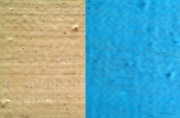Polyvinyl acetal
Description
1) A general name for a family of thermoplastic vinyl resins produced by the condensation of Polyvinyl alcohol with an Aldehyde. Examples are polyvinyl acetal (Alvar), polyvinyl formal (Formvar®) and polyvinyl butyral (Butvar®). They are used as adhesives, paints, coatings, and films.
2) A specific name for resins made from the condensation of polyvinyl alcohol with acetaldehyde (Alvar). Polyvinyl acetal is a thermoplastic, transparent resin used in lacquers, coating and for phonograph records. It is tough and hard with good adhesion but weathers less well than Polyvinyl acetate.
Note: these resins are not the same as acetal resins.
Synonyms and Related Terms
poly(vinyl acetal); polivinilacetal (Esp.); Alvar; Butvar® [Solutia]; Formvar® [Solutia]; Vinylite [Union Carbide];
Resources and Citations
- Krysia E. Spirydowicz, Elizabeth Simpson, Robert A. Blanchette, Arno P. Schniewind, Mauray K. Toutloff, Alison Murray, 'Alvar and Butvar: The Use of Polyvinyl Acetal Resins for the Treatment of the Wooden Artifacts from Gordion, Turkey', JAIC 40(1), 2001.
- R. J. Gettens, G.L. Stout, Painting Materials, A Short Encyclopaedia, Dover Publications, New York, 1966
- Richard S. Lewis, Hawley's Condensed Chemical Dictionary, Van Nostrand Reinhold, New York, 10th ed., 1993
- Theodore J. Reinhart, 'Glossary of Terms', Engineered Plastics, ASM International, 1988
- Art and Architecture Thesaurus Online, https://www.getty.edu/research/tools/vocabulary/aat/, J. Paul Getty Trust, Los Angeles, 2000
